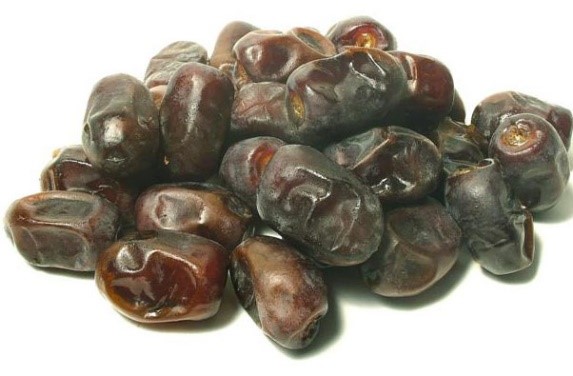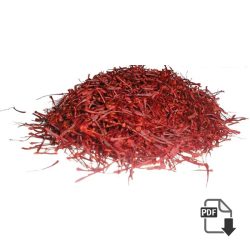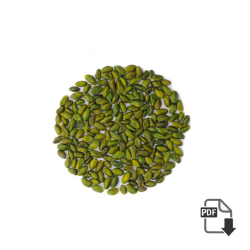pistachio
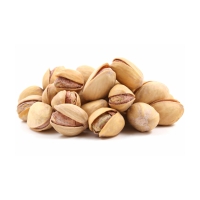
Pistacia vera often is confused with other species in the genus Pistacia that are also known as pistachio. These other species can be distinguished by their geographic distributions (in the wild) and their seeds which are much smaller and have a soft shell.
As of 2017, Iran accounted for over half the world’s production of pistachios.
Pistachio History
The pistachio tree is native to regions of Central Asia, including present-day Iran and Afghanistan.Archaeology shows that pistachio seeds were a common food as early as 6750 BCE.Pliny the Elder writes in his Natural History that pistacia, “well known among us”, was one of the trees unique to Syria, and that the seed was introduced into Italy by the Roman Proconsul in Syria, Lucius Vitellius the Elder (in office in 35 CE) and into Hispania at the same time by Flaccus Pompeius.

The early sixth-century manuscript De observatione ciborum (“On the observance of foods”) by Anthimus implies that pistacia remained well known in Europe in Late Antiquity. Archaeologists have found evidence from excavations at Jarmo in northeastern Iraq for the consumption of Atlantic pistachio.The Hanging Gardens of Babylon were said to have contained pistachio trees during the reign of King Merodach-Baladan about 700 BCE.
The modern pistachio P. vera was first cultivated in Bronze Age Central Asia, where the earliest example is from Djarkutan, modern Uzbekistan. It appears in Dioscurides as pistakia πιστάκια, recognizable as P. vera by its comparison to pine nuts.
In the 19th century, the pistachio was cultivated commercially in parts of the English-speaking world, such as Australia along with New Mexico and California where it was introduced in 1854 as a garden tree. In 1904 and 1905, David Fairchild of the United States Department of Agriculture introduced hardier cultivars to California collected from China, but it was not promoted as a commercial crop until 1929. Walter T. Swingle’s pistachios from Syria had already fruited well at Niles, California, by 1917.
Habitat of pistachio tree
Pistachio is a desert plant and is highly tolerant of saline soil. It has been reported to grow well when irrigated with water having 3,000–4,000 ppm of soluble salts. Pistachio trees are fairly hardy in the right conditions and can survive temperatures ranging between −10 °C (14 °F) in winter and 48 °C (118 °F) in summer.
They need a sunny position and well-drained soil. Pistachio trees do poorly in conditions of high humidity and are susceptible to root rot in winter if they get too much water and the soil is not sufficiently free-draining. Long, hot summers are required for proper ripening of the fruit.

The fruit is a drupe, containing an elongated seed, which is the edible portion. The seed, commonly thought of as a nut, is a culinary nut, not a botanical nut. The fruit has a hard, cream-colored exterior shell. The seed has a mauve-colored skin and light green flesh, with a distinctive flavor. When the fruit ripens, the shell changes from green to an autumnal yellow/red and abruptly splits partly open. This is known as dehiscence, and happens with an audible pop. The splitting open is a trait that has been selected by humans. Commercial cultivars vary in how consistently they split open.
Each pistachio tree averages around 50 kilograms (110 lb) of seeds, or around 50,000, every two years.
The shell of the pistachio is naturally a beige color, but it is sometimes dyed red or green in commercial pistachios. Originally, dye was applied by importers to hide stains on the shells caused when the seeds were picked by hand. Most pistachios are now picked by machine and the shells remain unstained, making dyeing unnecessary except to meet ingrained consumer expectations.
All Kind Of Pistachio
-
Round Fandoghi Pistachio
Round Iranian Fandoghi Pistachio High Quality Only for Export : This type of Pistachio is the least expensive type among all the pistachios. The reason why its price is lower than other types is because of its shape and high production volume in addition to low domestic demand. So, Round Fandoghi Pistachio forms most of the volume of pistachio export from Iran. The color of the Round Pistachio shell is naturally light cream. Also, it has the greenest kernel. Therefore, the greenness of its kernel and the reasonable price is the reason why producers mostly use Fandoghi to produce GPPK.
-
Jumbo Pistachio _ Kale Ghouchi
Iranian Jumbo Pistachio | Kale Ghuchi Pistachio : This type of Pistachio is the most delicious type among all the pistachios. The reason why it is tastier than the other type of pistachio is that it is fattier. The color of the Jumbo Pistachio shell is naturally light cream. As it is clear from its name, it has one of the largest kernels and producers categorize it as extra-large pistachio. This type of pistachio (Iranian Jumbo Pistachio | Kale Ghuchi Pistachio) is most similar to California pistachios. Also. it is one of the high demand pistachios in Iran`s Market.
-
Long Pistachio _ ahmad Aghaei
Ahmad Aghaei Pistachio ( Long iranian Pistachios ) : This type of Pistachio (Long Ahmad Aghaei Pistachio) is one of the popular types. The reason why it is popular than the other type of pistachio is that it has the lightest shell color. The color of the Pistachio shell is naturally light cream. However, Ahmadaghaie shell is brighter than the other types. As it is clear from its name, it is one of the long shape types of pistachios.
-
Super Long Pistachio _ Akbari
Another name for Long Akbari Pistachio is Super Long Pistachio. This name is based on the shape of the pistachio. This type of Pistachio is the most expensive and the oldest pistachio type in Iran. The reason why this type is more expensive than others, its that this type is bigger than other pistachio types, even bigger than Jumbo Pistachio. The local demand for this pistachio is extremely high because of the form of this pistachio.
The color of the Pistachio shell is naturally light cream. However, the Akbari shell is darker than the other types and it is closer to cream. Also, it has natural brownish spots on the shell. As it is clear from its name, it is one of the long shape types of pistachios.
-
Raw Pistachio Kernels
Producers make Pistachio Kernel from all types of Pistachios. A quality factor for kernels is their sizes. The more the color of the kernel`s second skin is violet and sharp the more it is popular among users. Higher the level of fat in pistachio kernels the tastier it is. Another interesting fact about pistachios without shell is that as the kernel size grows the color of kernel tends to more yellow-ish. So, if the kernel is premature its color is more green.
-
Green Pistachio Kernel
Producers make Pistachio Kernel from all types of Pistachios. A quality factor for kernels is their sizes. The more the color of the kernel`s second skin is violet and sharp the more it is popular among users. Higher the level of fat in pistachio kernels the tastier it is. Another interesting fact about pistachios without shell is that as the kernel size grows the color of kernel tends to more yellow-ish. So, if the kernel is premature its color is more green.
Farmers grow pistachios in provinces that have a proper climate for pistachios, such as Kerman, Khorasan, Yazd, Markazi or cities like Damghan.
The tree of this pistachio starts blooming in the first weeks of April. The harvest season for new crop is late September until Mid- October each year. So, we suggest booking your order for the new crop and contact us in the first weeks of September.
Benefits of pistachios
1 : Rich in nutrients:
Pistachios contain many important nutrients. According to the United States Department of Agriculture (USDA), 1 ounce or approximately 49 kernels of unroasted nuts contain:
- Calories: 159
- Protein: 5.72 grams (g)
- Fat: 12.85 g
- Carbohydrates: 7.70 g
- Fiber: 3.00 g
- Sugars: 2.17 g
- Magnesium: 34 milligrams (mg)
- Potassium: 291 mg
- Phosphorus: 139 mg
- Vitamin B-6: 0.482 mg
- Thiamin: 0.247 mg
A serving of pistachios provides about 37 percent of the recommended daily vitamin B-6 intake or 1.3 mg for adults. Vitamin B-6 plays a vital role in the body, particularly in relation to protein metabolism and cognitive development.
2 : Low in calories
Pistachios are one of the lowest calorie nuts, which means people can enjoy the health benefits of nuts while more easily staying within their daily calorie limits. One ounce of macadamia nuts, for example, contains 204 calories, while 1 ounce of pecans provides 196 calories. The same 1 ounce of pistachios contains just 159 calories.
3 : Packed with antioxidants
Antioxidants are substances that play a critical role in health. They reduce the risk of cancer and other diseases by preventing damage to the body’s cells. Nuts and seeds contain several antioxidant compounds, but pistachios may have higher levels of some antioxidants than other nuts. Research reports that pistachios have among the highest levels of antioxidants including:
- γ-tocopherol
- phytosterols
- xanthophyll carotenoids
These substances have high antioxidant and anti-inflammatory effects. In one small study involving 28 participants with high cholesterol who ate 1 or 2 daily servings of pistachios over 4 weeks, researchers showed that they experienced an increase in their levels of the antioxidants lutein, α-carotene, and β-carotene compared to those who ate none.
4 : Beneficial for gut health
All nuts are rich in fiber, which encourages a healthy digestive system by moving food through the gut and preventing constipation. A type of fiber called prebiotics may also feed the good bacteria in the gut. Feeding the good bacteria helps them multiply and “crowd out” harmful bacteria. According to a small, 2012 study, eating pistachios may increase the levels of beneficial bacteria in the gut. In the study, volunteers ate a standard diet with either 0 ounces, 1.5 ounces, or 3 ounces of pistachios or almonds. Researchers collected stool samples and found that people who ate up to 3 ounces of pistachios daily showed an increase in potentially helpful gut bacteria, much more so than those who ate almonds.
5 : High in protein for vegans and vegetarians
Pistachios contribute to a person’s daily protein needs, at almost 6 g of protein per 1 ounce serving. Protein accounts for approximately 21 percent of the total weight of the nut, making it a good source for vegetarians and vegans, among others. Pistachios also boast a higher ratio of essential amino acids, the building blocks of protein, when compared with other nuts, including almonds, hazelnuts, pecans, and walnuts.

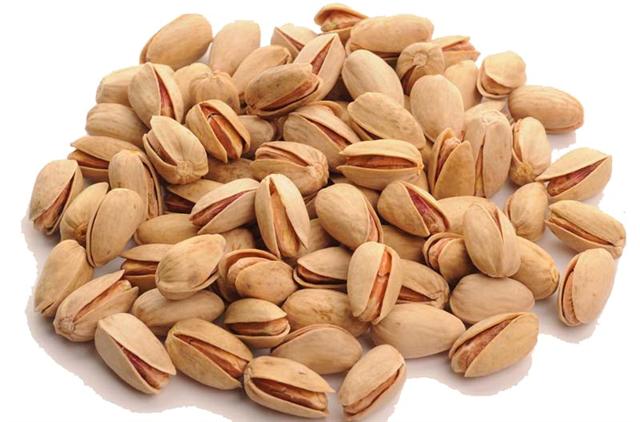
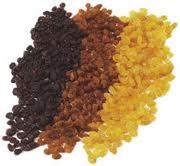 3 kind raisin
3 kind raisin 